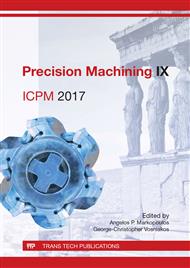p.331
p.339
p.347
p.354
p.362
p.370
p.378
p.386
p.394
Numerical Investigation of Mechanical Induced Stress during Precision End Milling Hardened Tool Steel
Abstract:
Hardened tool steels are widely used materials for forming dies, due to their increased strength and hardness. However, their machinability is very poor, due to the high hardness of the material, which leads to high cutting forces and premature failure of the cutting tools. This is also associated with machining induced tensile stresses within the work piece. No full factorial design has been performed when end milling tool steel, due to the high associated costs. Instead of physical experiments, numerical models are commonly used to save cost and time. However, most of the recent research focus was only on 2D FE-Models. 2D model can be used for simulation of some simplified process, however, the results are not sufficient for accurate prediction. Therefore, a 3D FE-model of a precision end milling process with a two-flute ball nose cutter were established in this paper, in order to build a multi cutting edge model. In the FE-Model, a subroutine was implemented to model work piece hardening during the cutting process. The subroutine realised an accurate prediction of the residual stress and cutting forces. In addition, a material removal criterion was developed and implemented. The influence of cutting parameters on cutting force for end milling H13 tool steel was studied, through full factorial numerical simulations, to evaluate the effectiveness of this FEA model. Subsequently, after validation of the FEM model through machining trials, empirical models were developed for predicting cutting forces and residual stress. The cutting parameters evaluated were cutting speed, feed rate and depth of cut. In summary, it was found that the simulation and the experiments had a good agreement on the value and trend of the residual stress. The FEM model can be effectively used to predict residual stress in the machined surface.
Info:
Periodical:
Pages:
362-369
Citation:
Online since:
August 2017
Authors:
Price:
Сopyright:
© 2017 Trans Tech Publications Ltd. All Rights Reserved
Share:
Citation:


